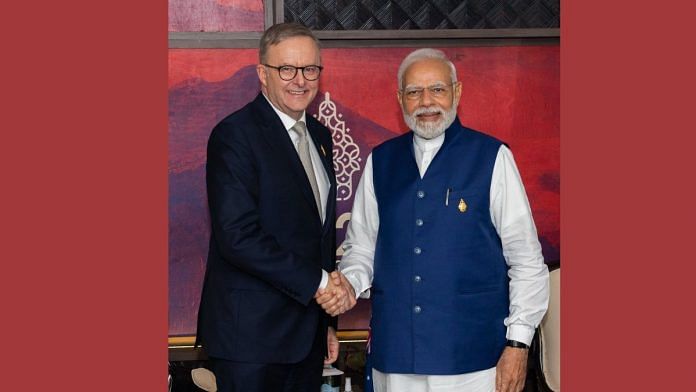New Delhi: To take Beijing head-on economically for reducing their trade dependency on China, the Australian Parliament ratified the Australia-India Economic Cooperation and Trade Agreement (AI-ECTA), adding another pillar in the already growing strategic relationship.
Australian Prime Minister Anthony Albanese, who is slated to visit India in March 2023, made the announcement Tuesday through a tweet in which he tagged his Indian counterpart Narendra Modi.
The AI-ECTA is an initial trade agreement which will finally culminate into a much bigger pact — Comprehensive Economic Cooperation Agreement (CECA), which is under negotiations.
Under the AI-ECTA, which will come into effect by December, India is hopeful that it will now be able to tap into Australia’s vast and rich mineral resources enabling it to reduce dependence on China, top official sources told ThePrint.
Sources also said India will be able to now import coking coal and uranium from Australia for zero duty even as New Delhi will seek to enhance services trade between both the “complimentary economies”.
In July, Coal and Mines Minister Pralhad Joshi had visited Australia to procure “commercially viable strategic critical minerals” from that country. The Union minister had visited the mineral-rich sites of Tianqi Lithium Kwinana and Greenbushes Mine.
India believes the AI-ECTA signed in April 2022, and thereafter that CECA, will also integrate it with the trading network and supply chains of the mega trade pact – Regional Comprehensive Economic Partnership (RCEP) — that entered into force earlier this year.
The RCEP is a free trade agreement amongst 14 countries — Australia, New Zealand, Brunei Darussalam, Cambodia, China, Japan, Laos, Singapore, Thailand, Vietnam, Korea, Malaysia, Myanmar and the Philippines.
India walked out of the RCEP in November 2019 due to China. In November 2020, it decided that New Delhi has the option of joining the pact in the future.
New Delhi now has free trade agreements (FTAs) with almost all RCEP members, except with China and New Zealand.
“While the RCEP is definitely a much more deeper, high-ambitious trade agreement, India has certainly been able to create a dent in that network,” said a source, who has been involved in the talks.
Besides, the source said, India is also looking at gaining major market access in services exports for its teeming IT professionals.
Though the CECA talks between India and Australia began in 2011, it remained stuck for years until both countries came closer strategically united by their joint acrimony against China.
India and Australia carry out joint military exercises now, the most comprehensive being the Malabar Exercise. Both are also partners in Quad along with the US and Japan.
Under the ECTA, two-way trade between India and Australia is expected to reach $45-50 billion in five years from $31 billion currently, according to an estimate by the Ministry of Commerce and Industry.
This is the second such trade pact that the Modi government has brought to reality. The Modi government, which was opposed to FTAs earlier and opted for more liberalisation of the foreign direct investments, believes that it is signing such deals now “without any lacunae” unlike the erstwhile United Progressive Alliance (UPA) dispensation.
According to Minister of Commerce and Industry Piyush Goyal, both the FTAs signed under the present government with the UAE and now with Australia have “unanimous support” of all stakeholders.
“With the UAE and Australia (trade pacts), every sector is happy. Every sector has supported this … And the IT sector is the biggest gainer. So, it also reflects that the services play an important and intrinsic role in free trade agreements,” Goyal told reporters Tuesday.
This FTA will also benefit Indian students studying in Australia with flexible working visas, he added.
Goyal also said that the ECTA has the potential to create 10 lakh jobs in India.
According to a statement issued by Australia, the agreement “will eliminate tariffs on over 90 per cent of Australian goods exports to India by value. India’s high tariffs on agriculture, such as sheepmeat, wool, cotton, seafood, macadamia nuts and avocados will be removed, with the vast majority, or 85 per cent, eliminated from the day ECTA enters into force. India will also substantially reduce its 150 per cent tariff on bottled wine above $5.”
Australia expands export market
Australia Tuesday also ratified a trade pact with the UK. Both these pacts will now enable the Albanese government to diversify its exports to a wider market for minerals, steel and agricultural goods and not continue haggling with China.
“New trade agreements with India and the UK will strengthen our existing trade and economic relationships. These new agreements will create new opportunities for trade diversification and great outcomes for Australian business and families,” said PM Albanese Tuesday.
“Today’s passage of legislation demonstrates Australia’s commitment to free trade and the rules-based trading system. It is an acknowledgement of the centrality of trade to our economic resilience and ongoing prosperity.”
As the AI-ECTA got passed by both Houses of the Australian Parliament, Trade Minister Don Farrell said exporters, businesses, workers and consumers will soon be able “to reap the opportunities and benefits of more open trade” with India and the UK.
“ECTA presents exciting opportunities for Australian and Indian businesses alike, paving the way for improved market access for businesses on both sides of the Indian Ocean. I am now looking forward to the second innings: negotiation of a full Comprehensive Economic Cooperation Agreement,” said Barry O’Farrell, High Commissioner of Australia to India.
(Edited by Tony Rai)






